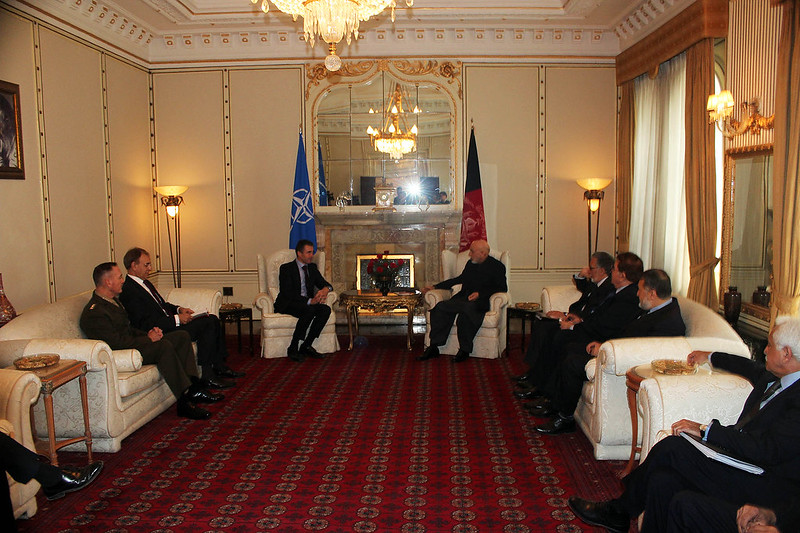Despite several warnings from security experts and allies, including from his own party, Trump is set to further reduce U.S. troops from Afghanistan—from 4,500 to 2,500.

After President Trump ordered to withdraw more troops from Afghanistan and Iraq—leaders within his party, as well as global allies, shared concerns that leaving “too soon” could result costly.
In a statement to CNN, NATO Secretary General Jens Stoltenberg warned that, “the price for leaving too soon or in an uncoordinated way could be very high,” arguing that global security continues to be at risk from international terrorist groups who might organize attacks from Afghanistan.
And former commander of all troops in Afghanistan, retired Marine Gen. John Allen, did not hold back in his condemnation of Trump’s withdrawal plan and his motivations for it: “I believe it’s political. There was no tactical, operational or strategic merit to doing this.”
Trump’s announcement has even been met with opposition from his supporters in the Republican party as well. Senate Majority Leader Mitch McConnell (R-S.C.) called it a “mistake” and warned against “any earth-shaking changes in regards to defense and foreign policy.”
Another top Republican on the House Armed Committee, Rep. Mac Thornberry (R-Tex.) called the troop reduction “unjustified” and that it ignores “dangers on the ground.”
In a statement, Stoltenberg emphasized that NATO went into Afghanistan to support the U.S. post 9/11—not to allow Afghanistan to become a safe haven for terrorist groups again. Stoltenberg then called on NATO allies to honor their commitment to withdraw in the right time.
“We went into Afghanistan together. And when the time is right, we should leave together in a coordinated and orderly way,” Stoltenberg said. He called on his NATO allies to “live up to this commitment, for our own security.”
Despite several warnings from security experts and allies, including from his own party, Trump is set to further reduce U.S. troops from Afghanistan—from 4,500 to 2,500. While withdrawing from Afghanistan was one of Trump’s campaign strategies—on his way out from office—he insists on withdrawing more troops, without regard to the reality on the ground.
In a memo to the White House, recent former Secretary of Defense Mark Esper, also expressed his opposition to the U.S. troop draw-down. Esper warned that it was the “unanimous recommendation of the chain of command” that the U.S. does not reduce or withdraw troops from Afghanistan. Several sources have indicated that this might have been the reason for Esper’s removal from office by Trump. Soon after Trump fired Esper in a tweet, he installed Christopher Miller, a loyalist.
Afghanistan civilians, especially Afghan women, do not want the U.S. to stay indefinitely in Afghanistan. They demand that the U.S. leave when the reality on the ground supports the decision and in a timely order. The Afghanistan government has also expressed their concerns on the existence of several terrorist groups and that they “need help from the U.S. to defeat them.”

“Systematic Murders of Afghan Journalists”
In the last couple of months since the intra-Afghan peace talks began in September, violence has been at its peak in the country. The Taliban group, while still engaging in peace talks, increased their attacks on Afghanistan civilians. The group has specifically targeted what is referred to as “soft targets,” including women leaders, members of civil society, public servants and journalists.
For example, Elyas Dayee, an experienced journalist who was awarded the Courageous Journalist Award of the year, was recently killed—just one day after the Afghanistan vice president disclosed intelligence reports revealed targeted members of civil society.
The killing of Dayee comes a few days after another highly respected journalist, Yama Siawash, was assassinated in Kabul. Three individuals, including former TOLOnews anchor and journalist Yama Siawash, were killed in an explosion on their way to work. In his late 20s, Siawash led a major news program—critical of the Taliban, other terrorist groups, and Afghanistan officials. Following threats, Siawash had left his job, but was still assassinated.
The Taliban’s use of violence as leverage at peace talks has been condemned by Afghans and global allies, including the U.S. The U.S. however, has not been able to convince the group for a comprehensive ceasefire or reduction in violence. Since the intra-Afghan talks opened in Doha on Sept. 12, the two sides have yet to agree on the ground rules of the negotiations—leaving the talks frozen for weeks.
This February, the Taliban and the U.S. signed a peace deal in which the Taliban agreed to not attack the U.S. and allied troops, but refused to agree to not attack the Afghanistan civilians and army. In the agreement, the Taliban also committed to not allow Afghanistan to be used against the U.S. and its allies in the future, without any monitoring mechanism or guarantees in place from the group.
You may also like:





